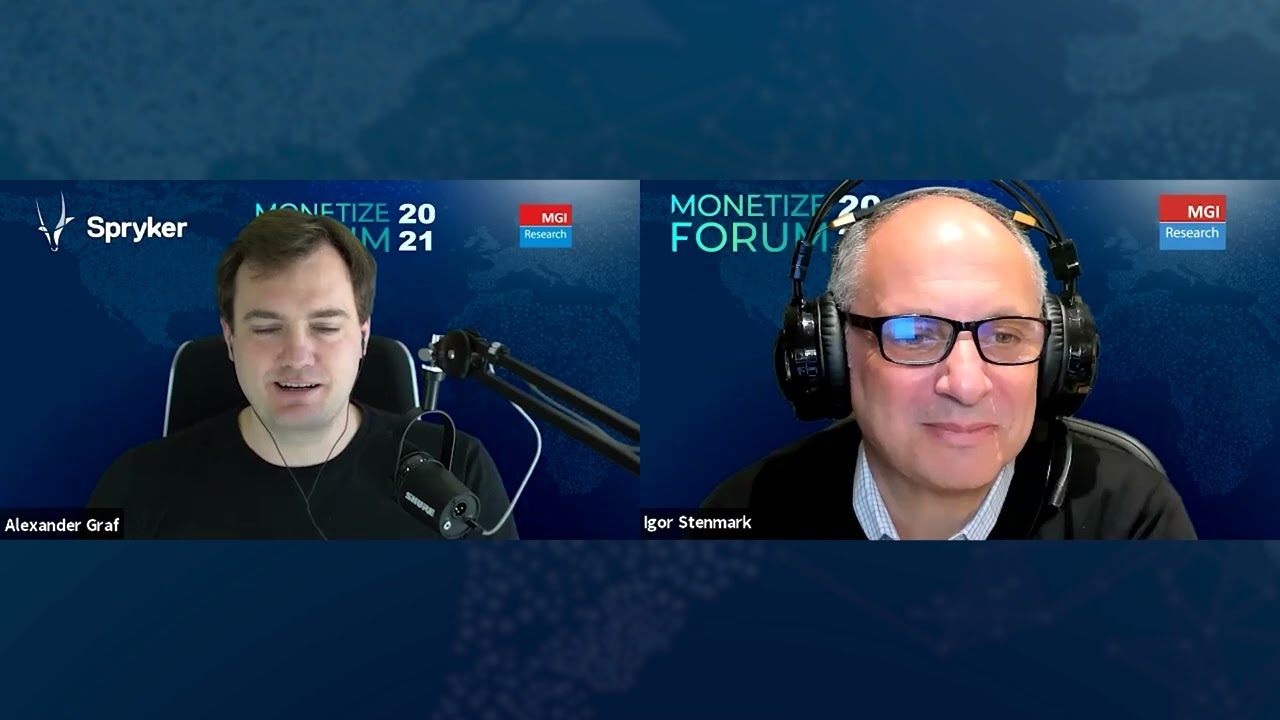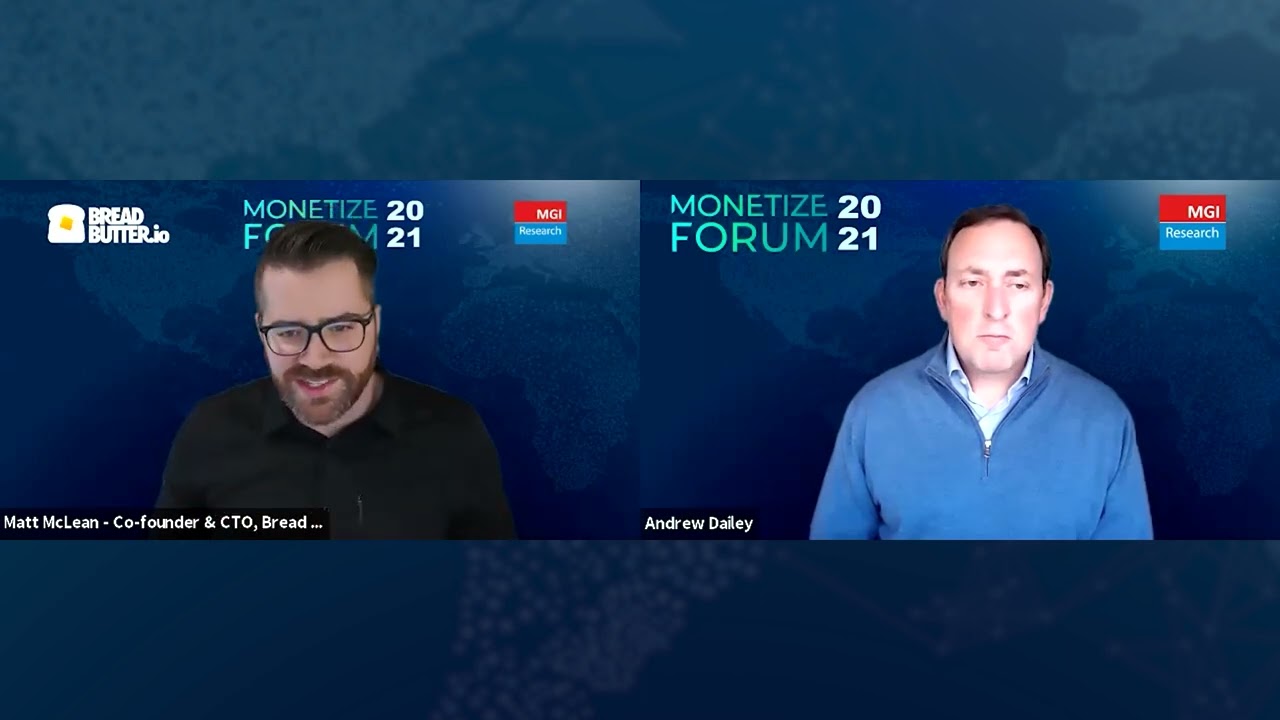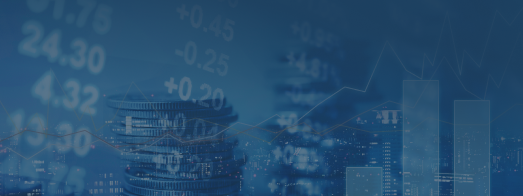The big event of 2020, generally and in the world of commerce, has been COVID-19. The question now is of which effects have been transitory and which will stay with us for the foreseeable future. To give us his view on the subject, we invited Adam Coyle, CEO of Digital River to speak at the 2021 Monetize Forum with MGI Research analyst Matthijs Koorn. Among topics discussed are the rise of direct-to-consumer channels and how that relates to the adoption of headless models, emerging payments systems as overall trends and in varying geographies, and the increasing importance of partnerships as businesses grow and start seeking seamless integrations of multiple best-of-breed solutions.
Key Issues
How has the pandemic shifted attention from marketplaces to direct-to-consumer channels?
What use case benefits from the Digital River accelerator programs?
Which emerging payments trends are worth investing in?
Guest Profile
Adam is the CEO of Digital River, joining its management team after three years at Siris Capital, where he is an executive partner and a member of the Digital River board. His prior experience also includes roles with Vantiv (now Worldpay), National Processing Company, Advent International, and First Data Corporation. He is a current director of Transaction Network Services and Intralinks and a former director of FirstBank, Paymentech, NYCE, and First Financial Bank.
Matthijs Koorn
Good afternoon. I’m joined for this session by Adam Coyle, the CEO of Digital River. Adam has had an impressive career in financial services with Vantiv (now FIS) and First Data (now Fiserv), among others. He has also served on the boards of several VC and private equity houses. Adam, welcome.
Adam Coyle
Thank you for having me. It’s good to be here.
Matthijs Koorn
All right. So, Digital River was founded in 1994, if I’m correct.
Adam Coyle
Yes.
Matthijs Koorn
I guess it’s one of the founding fathers of cross-border commerce covering both digital and physical goods, but I’m sure I’m missing a lot of what’s happened in between.
Adam Coyle
Yes, we spend a lot of time trying to convince people we’re not the company they might remember from 1994…But, you know, we’ve gone through a tremendous transformation over the past five years to really fundamentally rewrite our technology stack and refocus the business. Historically, we had operated as an end-to-end, full-stack e-commerce player, and we now consider ourselves the integrated back-end solution for brands who want to sell globally.
Our business today really focuses on everything that happens after you hit the buy button on an e-commerce website. We focus largely on brands that are selling direct to consumers, and we work across what I like to call the six dimensions of e-commerce. That’s both B2B and B2C (business-to-business and business-to-consumer), onshore (people who want to sell through distribution and have localized inventory) and cross-border, and in both physical goods and digital goods. I think I can say that we’re one of the few companies that covers all of those areas with equal capability.
Matthijs Koorn
Yes, I completely agree. I think in digital, there are a number of options, but for the combination of physical and digital, you can count them on the fingers of one hand, particularly across all those dimensions.
Adam Coyle
Yes.
Matthijs Koorn
So, looking back at 2020 (which you’ve already touched on a little bit), what did you see? What are your observations on both B2B and B2C?
Adam Coyle
Well, let’s just say that 2020 was a year to remember…and to forget, for all of us. I think it was really a watershed year for e-commerce, though, across all dimensions. When the world started to go into lockdown in the early spring, we saw a tremendous shift in both the priorities of our clients and in consumer behaviors. Generally, what we’ve seen is that consumers have shifted their behavior. Those who had previously shopped online but not directly from a brand or manufacturer were forced to do so in many cases, either because that brand’s products weren’t deemed essential and weren’t being delivered by a marketplace or because scarcity made their products very hard to find, forcing consumers to begin purchasing from the brand’s direct sites. We’ve seen what seems to be a permanent shift of behavior where more and more consumers are going directly to the brand instead of to a marketplace for the products that they already know and love. At the same time, we’ve also seen a shift in the minds of brands and people that sell online directly. They’re realizing that they can’t worry as much about channel conflict. They need to have this direct-to-consumer touch point.
So, the combination of those things coming together has set the stage for a permanent, long-term shift in how businesses think about going to market. Retail will always have its place, and marketplaces will always have their place, but the rise of the direct-to-customer channel is a trend that’s been kickstarted in 2020 and will remain with us forever.
Matthijs Koorn
Yes, I completely agree with that. Were there any countries or regions that stood out in particular in terms of notable swings or ups and downs?
Adam Coyle
Yes, it’s kind of crazy. Really, we saw strong demand across all the regions even though some regions were arguably more affected by the pandemic and others less so. Interestingly, in places where COVID-19 was particularly acute, we actually saw stronger activity than we would have ever expected. You might think that with the economy shut down, you would have seen some runoff of business, but demand in these areas was particularly strong for products that you might not even suspect were in demand. Similarly, places that weren’t as affected still seemed to catch on to the whole e-commerce buzz around the world, and we saw strong demand in those economies as well.
So, it’s hard to make generalizations because I think demand was strong around the world, clearly in verticals, and particularly in the verticals that we serve. We’re very strong in consumer electronics, and we saw amazing demand there, obviously, as people began to refresh their computer setups for work-from-home. Webcams, mice, wireless keyboards, and other products were very, very popular. Additionally, products in the gaming categories were also in demand as people were looking for stuff to do while they were tied to their home base.
Matthijs Koorn
Yes, one of our other speakers also referred to that. He mentioned Brazil, specifically, where GDP was down 8% but e-commerce rose 40% or 50%. So, that’s very much in line with your observation even though, typically, that would be an economy where you would have question marks.
Adam Coyle
Yes, absolutely.
Matthijs Koorn
You already mentioned the emergence of marketplaces and that you pulled apart the current stack of technologies. Is that where your headless commerce strategy is coming into play and providing you additional benefits?
Adam Coyle
Yes, I think what we’re seeing with the marketplaces is the evolution of the e-commerce market as a whole. Brands are getting more sophisticated about how they view the various channels. Historically, we saw e-commerce as all one thing, and it’s now becoming far more nuanced. Consumers are becoming far more sophisticated in their approach to the market and realize that, while marketplaces have a place, there’s also a place for the direct-to-customer channel. I think that’s what’s evolving as our common understanding of how we shop online is changing.
Obviously, the marketplaces are always going to be powerful, and we’ve seen tremendous growth from them as a platform for distributing certain types of goods and as a source to acquire new consumers. However, we’re increasingly seeing that brands are recognizing that they need to migrate the customers who have discovered their products to a direct channel where they can provide a higher level of service, a higher level of brand affinity, and a stronger direct relationship with the customer. There are some categories of goods that will always be very well-suited for the marketplaces, just as there are those well-suited for retail. That said, there are also categories that will be really well-suited for the direct-to-customer channel. Nike is probably the best example of a company following this trend, and I read statistics a month or so ago that said their business was just exponentially through the roof.
Matthijs Koorn
Yes, that was in Financial Times, I believe, this weekend. I read that their business is back to normal levels thanks to online sales. It’s a combination of direct and marketplaces, but mainly direct. On the topic of brands, at the end of 2020, you launched three accelerator programs for brands. Perhaps it’s still early to discuss, but could you share some insights as to why you did that and any particular results or observations?
Adam Coyle
Absolutely. I think what we’re seeing is that the trend towards direct-to-consumer has inspired brands to rethink their e-commerce presence and really look for newer and better solutions. As they evolve from, for example, setting up a little store online that sells locally towards migration into a marketplace that gives them broader reach, eventually they may want to develop a direct-to-customer channel as they grow and establish a larger presence.
As brands get into that stage, they’re looking for the opportunity to migrate off the marketplace or perhaps migrate off a full-stack or end-to-end e-commerce solution to create something that’s truly differentiated. The problem is that they may not be ready to go all in on a multimillion-dollar e-commerce implementation. The accelerators are really intended to capture that market: brands who are getting too big for the marketplace presence and want some differentiation from what’s offered by the full-stack e-commerce solutions but aren’t quite ready to take on the full, intense implementation. The accelerators give them a highly customizable, highly differentiated solution packaged in a way that makes it easy to consume and very low cost to get started with. Then, ultimately, as they get bigger and bigger and become global brands, they move into solutions that are far more bespoke, and we obviously plug into all the major ecosystems for those customers’ needs as well.
Matthijs Koorn
Yes, so they can grow with you, or you can grow with them.
Adam Coyle
Absolutely, yes. It’s all about helping them get online and really provide a differentiated consumer experience that meets the needs of their particular business and their particular consumers. As I like to say, the experience you have when you go to and buy from a fashion website is very different than the experience you have if you go to an auto parts website.
Matthijs Koorn
True. How important are partnerships for you, considering the last 12 to 18 months but also going forward?
Adam Coyle
As the e-commerce services or delivery market is evolving, there’s a place for the full-stack solutions, but as you start to move up the stack, people increasingly want to put the best-of-breed solutions together. So, partnerships are a necessity, and if you’re a provider of one of those solutions, you inherently have to work with the other pieces because nobody just buys one piece. They buy a piece to put it together with a whole. So, obviously, good relationships with the other providers in the space and the systems integrators—the people who put those solutions together—are kind of critical. And finding the teams that can work together seamlessly is a big part of what we’re focused on and what I think we’ll see the industry continue to evolve in.
We like to believe that e-commerce is an ecosystem, and there are many parties who have to interact to truly deliver a great solution that’s customized and unique to the needs of a particular business. That’s the approach we take, and we’ve been very active in the last couple of years cultivating our relationships with different providers in that space, whether that be a fulfillment logistics provider or a customer experience provider.
Matthijs Koorn
Many partnerships center around a certain ecosystem. Is that also something you’re focusing on? And, if so, is there a specific first-among-equals ecosystem you’re focusing on?
Adam Coyle
Yes, that’s a great question because the ecosystems each have their own personalities and characteristics. Generally, the ecosystems seem to center around the commerce solution—we have specific ones like the Magento ecosystem, the Salesforce ecosystem, the SAP ecosystem, or the Shopify ecosystem. They all have a place to play, and understanding what’s unique about each and how to operate in each is a big part of the secret to being successful in this marketplace. It’s particularly key for companies like us that are going to operate in those ecosystems with other players who all have their own personalities and unique qualities. Part of the richness I think we’re seeing develop in the e-commerce industry is that there are all these solutions out there. Brands just need a path to find them and connect with the solution that’s going to work best for them. That’s really getting back to why we got into the accelerator programs last year.
Matthijs Koorn
Yes, I completely agree with that. An important part of your solution and of your effort in helping clients go global—but also local—is payments. We’ve seen a tremendous amount of change and innovation in payments. How hard is it for you (as someone with a strong and deep payments background) and your organization to keep up and also prioritize with all these changes?
Adam Coyle
Yes, you and I are both well-versed in the payments industry, and it has been an interesting career because of the new payment types that come up all the time. It is challenging to keep up, and there’s a fine line to be navigated on when to include a new payment type. It’s the chicken or the egg problem: “Do I add the payment type to get the volume, or do I wait for the volume to come before I add the payment type?” Keeping on top of these developments is critical.
We do see some big trends, globally, that we’re investing in—things like the “buy-now-pay-later” which sort of exploded in the last 12 to 18 months. The players have certainly been around longer than that, but it really came to the forefront in 2020. We see a lot of demand for that with players like Klarna who are really pushing heavily into the United States and PayPal which is coming out with its offering. That’s in addition to some of the incumbents or natives like the Affirms, the Afterpays, and others in this world.
So, that has been a real trend as people look for a different way to essentially buy on credit. I think our notions of how we buy on credit are changing with the millennial generation. They have a different view of things. They’re very tech-first, and technology has made a lot of these options available.
The other big trend we see is in the B2B space. Regarding the earlier question of what happened in 2020, I think 2020 was the wakeup year for a lot of B2B sellers who realized that they needed a direct-to-customer online channel and that marketplaces don’t really serve them well. There are some interesting, specialized marketplaces for goods and services that are evolving around manufacturing and things like that, and we’ll see how that goes, but that’s still a very new market. What we saw was a lot of B2B sellers express real interest in having a direct-to-customer channel, and, obviously, they need different payment types. The dynamics of the B2B marketplace alone demands that sellers extend credit to their buyers in the form of an invoice. That’s something we’ve invested in as well in 2020.
Matthijs Koorn
Yes, and in B2B, even before being able to issue an invoice, you have a procure-to-pay process, you may need to issue a PO number, et cetera, et cetera. So, simply from a process perspective it’s a different animal.
Adam Coyle
Yes, I’ll just chime in with one last thing which is another interesting development to watch. That is the advent of open banking, and, obviously, that has been particularly strong in Europe. It’s sort of coming to the US where we have a little bit of a different view on what constitutes open banking. Eventually, I think you’ll see it permeate the world. But even in these beginning stages, I think there will be a big impact on how we think about how we pay as new technology and systems get developed around the open banking concept.
Matthijs Koorn
Yes. I think it’s good to remember that open banking is an umbrella term for a couple of developments. Take Pix in Brazil, which is more about instant payments. And even though Europe talks a lot about open banking and things like instant payments, it’s not entirely a reality yet in all of Europe. So as Europeans, let’s not get ahead of ourselves on that perspective. Indeed, though, I do think that will spread and grow internationally.
Another thing we see a lot is the growing importance of developers in sales cycles. You already alluded to that a little bit as far as millennials being tech-savvy. Has that made you reconsider sales processes and, for instance, focus more on tech-savvy sales staff or make changes to these processes driven by client demands?
Adam Coyle
We have invested a lot to build and then continue to update and evolve our developer tools because I think you’re right. In this world, we’re inherently networked through ecosystems which create these environments where you’re by definition plugging and playing solutions together to create a very customized solution for your business’s and client’s needs. Here, the influence that the developer (a term kind of broadly conceived) has in the sales process grows exponentially because they want solutions that are going to first and foremost work for their client. They want to know that it’s going to work when they get it done and that, secondly, it’s going to be relatively easy to implement.
That’s something else we have invested a lot in—creating solutions will be easy for the developers, whether that’s an in-house developer, a client doing it themselves, or a systems integrator who’s been hired to basically put together a solution for someone. We want to provide them the tools, the documentation, and the know-how they’ll need to put that solution together. Repeatability obviously has benefits, and the fact that you’ve put it together once or twice or 10 times in an ecosystem always makes things easier. We also want to be able to have the tools necessary. You have to have the tools necessary for the person who’s just starting out with a solution in an ecosystem or environment they’ve never worked in before, and I think you’re going to see a lot more focus on that.
There are definitely people who are enablers in that space, companies like MuleSoft, for example, who focus on making it easy to plug disparate systems together. Even so, businesses will continue to need to invest in the tools themselves to make it easy for developers (whether third party or in-house) to put systems together because that’s just the way it’s going to go. You’re going to see increasing specialization and increasing capabilities delivered through apps, whether that’s an open banking solution or a product catalog solution. It’s a big trend.
Matthijs Koorn
Agreed. It’s a collection of apps that makes the solution in many cases.
Adam Coyle
Yes, for sure.
Matthijs Koorn
All right. Last but not least (and putting you on the spot a little bit), could you share a prediction with us? What do you think we’ll see in 2021? Will this commerce and online momentum continue? Will we see people flock back to the stores?
Adam Coyle
I’ll give you my personal view. I think that when a lot of the COVID restrictions are finally lifted, you’re going to see many people flock to cruise lines and hotels because I think we’re all getting tired of this. I think where retail is concerned, we’re strong believers that we have seen a permanent shift. And I can tell you that our clients are strong believers that they’ve seen a permanent shift. What was really interesting about 2020 in hindsight is this: consumer behavior changed, we believe permanently, because people were forced to find new ways to buy which they then realized were convenient, easy, and worth continuing.
However, another real change occurred in the mindset of a lot of our customers, people who might have previously had a direct-to-customer channel which they saw as a secondary asset. These people now realize that this is their most strategic channel, it’s essential, and they have to invest in it. So, I think that you’re going to see additional investment there. If a business has already started investing, they’re going to invest more, and if they haven’t really started investing, you’ll really see them move forward on that. That’s going to cut across all aspects of e-commerce. We’re all familiar with it in B2C, but I think you’re going to see a tremendous amount of B2B e-commerce investment.
When we went into lockdowns, companies basically had to keep doing business without being face-to-face, and I think they kind of got used to that. If you’re a B2B buyer, you might have found that it was way more efficient to buy through website reviews, Zoom meetings, and things like that rather than having people come on-site, clearing your day, and the like. I think we’ve seen a fundamental shift.
So, we’re huge believers that this is something that’s going to stick with us. How much it will stick with us over the bump will depend greatly on what vertical we’re in, but the shift of share is permanent, both in B2B and B2C. It’s something that we’ll have to continue to invest in during 2021, and I think some really exciting stuff will come out of it.
Matthijs Koorn
Excellent. Great insights. Adam, thank you very much. As always, it’s a pleasure.
Adam Coyle
Thank you, and likewise. Thanks to everybody who’s watching.





